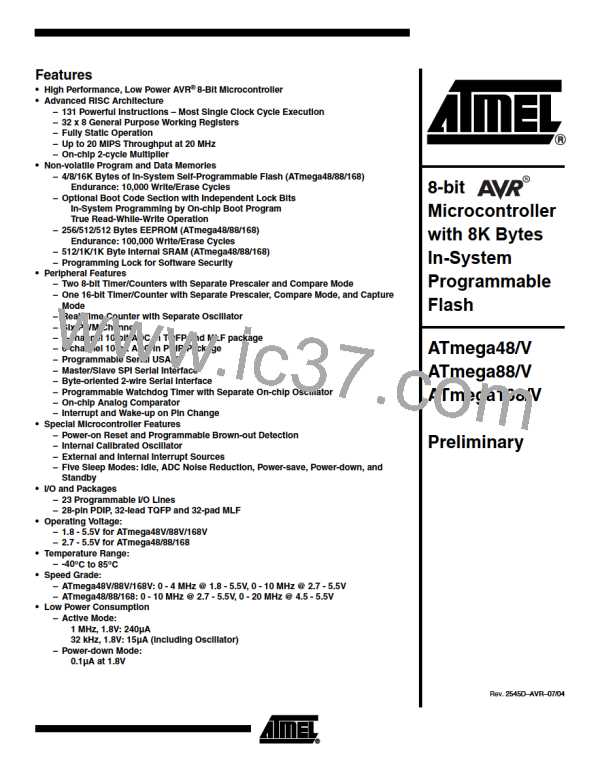SPI Status Register – SPSR
Bit
7
SPIF
R
6
5
–
4
–
3
–
2
–
1
–
0
SPI2X
R/W
0
WCOL
SPSR
Read/Write
Initial Value
R
0
R
0
R
0
R
0
R
0
R
0
0
• Bit 7 – SPIF: SPI Interrupt Flag
When a serial transfer is complete, the SPIF Flag is set. An interrupt is generated if
SPIE in SPCR is set and global interrupts are enabled. If SS is an input and is driven low
when the SPI is in Master mode, this will also set the SPIF Flag. SPIF is cleared by
hardware when executing the corresponding interrupt handling vector. Alternatively, the
SPIF bit is cleared by first reading the SPI Status Register with SPIF set, then accessing
the SPI Data Register (SPDR).
• Bit 6 – WCOL: Write COLlision Flag
The WCOL bit is set if the SPI Data Register (SPDR) is written during a data transfer.
The WCOL bit (and the SPIF bit) are cleared by first reading the SPI Status Register
with WCOL set, and then accessing the SPI Data Register.
• Bit 5..1 – Res: Reserved Bits
These bits are reserved bits in the ATmega48/88/168 and will always read as zero.
• Bit 0 – SPI2X: Double SPI Speed Bit
When this bit is written logic one the SPI speed (SCK Frequency) will be doubled when
the SPI is in Master mode (see Table 71). This means that the minimum SCK period will
be two CPU clock periods. When the SPI is configured as Slave, the SPI is only guaran-
teed to work at fosc/4 or lower.
The SPI interface on the ATmega48/88/168 is also used for program memory and
EEPROM downloading or uploading. See page 286 for serial programming and
verification.
SPI Data Register – SPDR
Bit
7
6
5
4
3
2
1
0
MSB
R/W
X
LSB
R/W
X
SPDR
Read/Write
Initial Value
R/W
X
R/W
X
R/W
X
R/W
X
R/W
X
R/W
X
Undefined
The SPI Data Register is a read/write register used for data transfer between the Regis-
ter File and the SPI Shift Register. Writing to the register initiates data transmission.
Reading the register causes the Shift Register Receive buffer to be read.
Data Modes
There are four combinations of SCK phase and polarity with respect to serial data,
which are determined by control bits CPHA and CPOL. The SPI data transfer formats
are shown in Figure 68 and Figure 69. Data bits are shifted out and latched in on oppo-
site edges of the SCK signal, ensuring sufficient time for data signals to stabilize. This is
clearly seen by summarizing Table 69 and Table 70, as done below.
160
ATmega48/88/168
2545D–AVR–07/04

 ATMEL [ ATMEL ]
ATMEL [ ATMEL ]